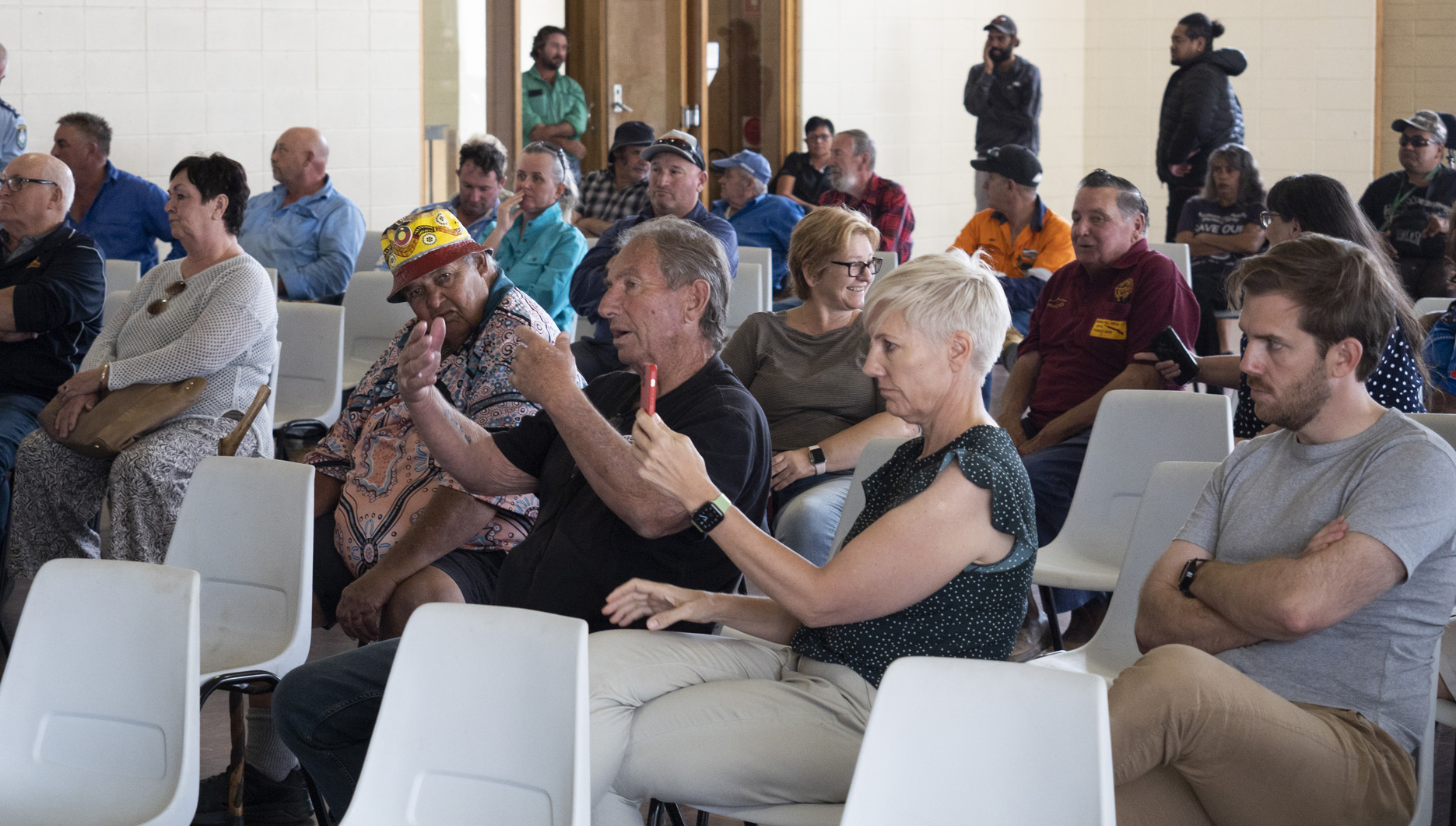By Dan Schulz
A community meeting was held at Menindee on Tuesday by the Emergency Operations Centre, an inter-agency operation established on Sunday to coordinate operations in response to the fish kills, provide drinking water to residents and to coordinate the removal of decaying fish from the river.
The meeting was facilitated by Andrew Mensforth, Inspector with the Barrier Police Department who opened the meeting by saying, “I am aware there are the environmental side of things that need to be addressed and looked at, but the EOC was established to ensure the Menindee community has a fresh and clean water supply.”
Despite attempts to limit the conversation to water quality testing and treatment, the frustrated Menindee community was quick to outline the ongoing environmental degradation of the Darling-Baaka and Menindee Lakes, and the decades of inadequate water policy and poor management that have led to the massive fish kills in recent years.
The latest, which began on Friday, is the largest Menindee has seen.
The most sobering comments from the floor came from Sunset Strip resident Barry Stone who said, “We’ve been screaming at you for years to fix this system, we’ve shut bridges, we’ve protested, nobody has listened to anyone here in Menindee. You come here and you say you respect the Traditional Owners of the land and then treat it like this.
“During the drought I dragged 11 kangaroos from my place that just dropped dead, emus dropping dead, birds falling out of the sky and not one of you have ever seen that because you don’t live here. And now this fish kill?
“The whole thing is a joke.”
Graham Attenborough, Chief Operating Officer for Water at NSW Department of Planning, Industry and Environment assured the community they had done everything possible to manage the hypoxic blackwater, with releases increased as early as last Wednesday to try to improve water quality, and on Sunday they increased releases from Menindee outlet from 2900 ML/d to 4000 ML/d which had a good outcome for dissolved oxygen and may have saved some fish from suffocating.
But the conversation was quickly derailed when he mentioned that DPIE would be installing more remote automatic samplers which measure water quality in real time. He was reminded by residents that the promise to establish more remote automatic samplers, including in the Menindee weir pool, has not been delivered in the three years since the last massive fish kill.
Menindee resident David Baker asked, “In 2019 we had fish kills in the weir pool and you still don’t have a testing station there for oxygen. That’s four years. Do you reckon that’s acceptable?”
A large concern for the Menindee community was the question of what could possibly be in the water to cause such a large fish kill, with senior residents Ross Files and Bob Looney commenting that they had never seen fish kills as large as this caused by floods in the 130 years between them.
Floods are generally a productive time, with Ross Files commenting that he usually has to mow his lawn after a flood because the water brings strong growth but this time the grass is dead.
The Menindee community has been long asking for further testing of its water. Carmen Dwyer, Executive Director Regulatory Operations at NSW Environment Protection Authority (EPA), explained that they were undergoing toxiciology tests for heavy metals and pesticides, which was a welcome response. Those results will be made available to the community.
When members of the Menindee community were reassured that the town water supply was drinkable, resident Jan Fennell asked for 10 mugs of tap water to be provided to each agency representative to drink, to ensure they were genuine on their commitment that the water is safe.
The action plan to remove dead fish using aquatic booms to move the carcasses to the bank and remove them using an excavator, was also welcome, however the EPA is unsure how many fish they will be able to remove especially as they have begun to sink to the bottom of the river.
Director of freshwater environments at DPI, Cameron Lay explained the contributing factors to the fish death event, including the absence of a fish way at the main weir which meant fish are attracted to the small flows from the regulator, accumulate in large numbers below main weir.
This combined with the enormous amounts of debris brought into the river channel after the first large flood in a decade, and it was these dynamics that had caused hypoxic water.
The reason the Menindee has such large fish kills, Mr Lay explained, is because it is the native fish breeding ground and nursery for the entire Murray-Darling, the heart of the system.
“This means we are going accumulate large quantities fish in this part of the river, and when water quality declines we see what is happening today.”
Ross Leddra of the Darling River Action Group wanted to know why, if Menindee is so significant to the fish health in the rest of the Murray-Darling Basin, why the lakes were managed predominately for flows downstream, and Menindee had very little protections from upstream extraction to ensure its security and productivity.
“The community continue to feel abandoned by water policy.”
Which goes to the heart of the sentiment at the community meeting, that the community continue to feel abandoned by water policy and are yet to experience effective and genuine consultation on managing the river and lakes.
With reductions in flows down the Darling River, declining long-term storage patterns in Menindee Lakes, and now a large flood, which was supposed to bring abundance, has destroyed homes, and in the aftermath has seen the largest mass fish kill in the Murray-Darling Basin’s known history.
Despite the attempts to reassure Menindee that everything possible has and continues to be done in regards to the fish kills, the agency representatives bore the brunt of an exhausted and angry community.










